Slowenien |
|
|
|
| Übersicht – Contents: | |
Diese Seite ist Teil des Projektes
Slowenien |
|
|
|
| Übersicht – Contents: | |
Flaggen – Flags: |
|
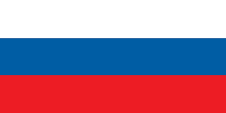 |
Nationalflagge – national flag, |
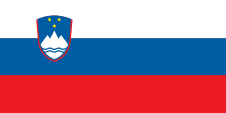 |
Staatsflagge – state flag, |
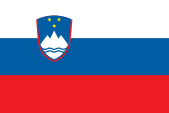 |
Handelsflagge und Staatsflagge zur See |
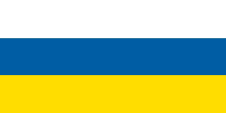 |
Gösch – Naval jack, |
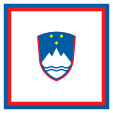 |
Flagge des Präsidenten |
historische Flaggen – historical Flags: |
|
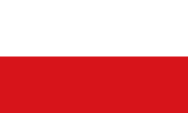 |
1861–1919, |
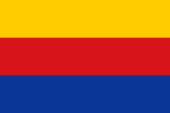 |
bis/to 1918, |
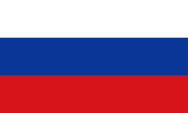 |
1848–1919, |
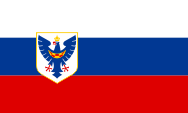 |
1943–1945, Slovensko Domobranstvo, |
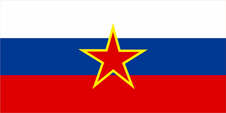 |
1947–1991, |
|
|
|
| Die heutige Flagge Sloweniens wurde am 25.06.1991 anlässlich der Unabhängigkeit eingeführt. Sie zeigt drei waagerechte Streifen in Weiß, Blau und Rot mit dem Staatswappen im Obereck, genau zwischen dem weißen und blauen Streifen. Die Farben der heutigen Flagge sind zuletzt mit dem "Gesetz über das Wappen, die Flagge und die Nationalhymne der Republik Slowenien und über die slowenische Nationalflagge" vom 21.10.1994 festgelegt worden, allerdings definiert in einem unbekannten, nicht gebräuchlichen Farbraum, dem "SCOTDIC Code 777—Int'l Colour Codification System". Damit wäre Blau = N46 N722509, Rot = N23 N074014 und Gelb = N6 N197512. Deren Mischung lässt sich in RGB darstellen, so dass man einigermaßen passende Pantone-Farbtöne eingrenzen kann: Blau = Pantone 301, Rot = Pantone 1788 und Gelb = 100% Y. |
The
today’s flag of Slovenia was introduced on the 25th of June in 1991 on the
occasion of the independence. It shows three horizontal stripes in white,
blue and red with the coat of arms in the upper staff quadrant exactly
between the white and the blue stripe. The colours of today's flag were last defined by the "Act on the Coat of Arms, Flag and National Anthem of the Republic of Slovenia and on the Slovenian National Flag" of 21st of October in 1994, but defined in an unknown, non-common colour space, the "SCOTDIC Code 777-Int'l Colour Codification System". This would make blue = N46 N722509, red = N23 N074014 and yellow = N6 N197512. Their mixture can be represented in RGB, so that one can narrow down reasonably suitable Pantone colour tones: Blue = Pantone 301, Red = Pantone 1788 and Yellow = 100% Y. |
| Viele slawische Völker schufen sich in der Zeit nach 1848 (dem Jahr der Revolutionen) – im Zusammenhang mit einem erstarkenden slawischen Nationalismus – eigene Flaggen. Dabei spielte der Panslawismus eine bedeutende Rolle, eine politische Bewegung des 18./19. Jahrhunderts, die alle Slawen in einer Nation einen wollte. Die meisten slawischen Völker lebten jedoch in dieser Zeit unter österreichischer, türkischer oder auch deutscher Herrschaft. Der Panslawismus sah in Russland ein Vorbild, denn die Russen waren, neben Serbien und Montenegro, die einzige freie slawische Nation. Und so wurden die Farben der russischen Flagge zum Idol der Panslawisten, und letztlich farbliches Vorbild bei der Gestaltung der Flaggen vieler slawischer Nationen. Diese Flaggen trugen und tragen bis auf wenige Ausnahmen die russischen Farben Weiß, Blau und Rot als gemeinsames Merkmal. Daher wird diese Farbkombination "Panslawische Farben" genannt. |
Many Slavic nations create on the 19th century own flags – in context with a
growing Slavic nationalism. Thereby played the Panslavism an important roll,
a political movement of the 18th/19th century, which would unite all Slavs
in one nation. The most Slavic nations however lived in this times under Austrian, Turkish or even German rule. The Panslavism saw in Russia a model, because the Russians were, apart from Serbia and Montenegro, the only free Slavic nation. In this way the colours of the Russian flag became to an idol of the Panslavists, and in the end to a colour's pattern in the designing of the flags of many Slavic nations. Those flags carried and carry except few exceptions the Russian colours white, blue and red as mutual attribute. From there this colour's combination is named "Panslavic Colours". |
| Im Jahre 1848 schufen sich auch die Slowenen eine Flagge in den Farben Weiß, Blau und Rot. Einerseits nahmen sie zwar eine Flagge in den "Panslawische Farben" an – eine exakte Kopie der russischen Flagge, die 1916 offiziell wurde. Andererseits übernahmen sie damit auch die Farben des Herzogtums Krain als die ihren. Krain ist das Kernland des heutigen Slowenien. Es war ein Kronland er Österreichisch-Ungarischen Monarchie, genau wie Istrien und Görz und Gradisca. |
In the
year 1848 the Slowenes created their own flag in the colours white, blue and
red. On the one hand they adoped a flag in the "Panslavian Colours" – an exact copy of the Russian flag, which became official in 1916. On the other hand in this way they took over the colours of the Duchy of Carniola. Carniola is the core of the today’s Slovenia. It was a crown-land of the Austria-Hungaryn monarchy, just like Istria and Goerz and Gradisca. |
| Nach dem Ende von Österreich-Ungarn bildete sich in der Region das Königreich der Serben, Kroaten und Slowenen, das ab 1929 Jugoslawien hieß, zu dem das heutige Slowenien bis 1991 gehörte. | After the end of Austria-Hungary, the Kingdom of Serbs, Croats and Slovenes was formed in the region, which was called Yugoslavia from 1929, to which the todays Slovenia belonged until 1991. |
| In der 1945 durch Tito proklamierten Föderativen Volksrepublik Jugoslawien konnten die südslawischen Nationen in ihren Republiken ihre Nationalfarben (meist Kombinationen der Panslawischen Farben) wieder auf eigenen Flaggen verwenden. Jedoch musste, wegen dem politischen System, ein roter Stern in der Mitte der Flagge verwendet werden. |
In the Federal People's Republic of Yugoslavia, proclaimed by Tito in 1945, the South Slavic nations were able to use their national colors (mostly combinations of Panslavic colors) on their own flags again, in their
own republics. However, because of the political system, a red star had to be used in the middle of the flag. |
| Quelle/Source: Die Welt der Flaggen, Wikipedia (D), Flags of all Nations, www.uradni-list.si | |
|
|
|
Wappen – Coat of Arms: |
|
 |
seit/since 1991, Wappen von Slowenien – coat of arms of Slovenia, Quelle/Source: nach/by Wikipedia (D) |
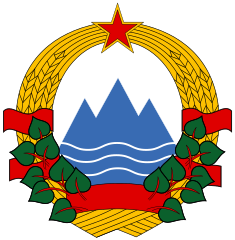 |
1945–1991, Wappen von Slowenien – coat of arms of Slovenia, Quelle/Source: Romanm, vectorized by إيهاب-عبيد [GFDL or CC-BY-SA-3.0], via Wikimedia Commons |
Bedeutung/Ursprung des Wappens – Meaning/Origin of the Coat of Arms: |
|
| Das
heutige Wappen Sloweniens wurde vom Bildhauer Marko Pogacnik geschaffen und
– wie die Flagge – im Jahre 1991 angenommen. Es zeigt in stilisierter Form
die Natur des Landes. Die drei Gipfel stellen die Bergspitzen des Berges
Triglav (Dreizack) dar, des höchsten Berges des Landes. Die beiden blauen Wellenlinien stehen für die Flüsse Drau und Save, aber auch für die Küste des Adriatischen Meeres. Die drei sechszackigen gelben Sterne über dem Triglav stammen aus dem Wappen der Stadt Celje (Cilli). Sie stehen aber auch für die historisch bedeutsamen Jahreszahlen 1918 (Unabhängigkeit von Österreich-Ungarn), 1945 (Unabhängigkeit vom Deutschen Reich) und 1991 (Unabhängigkeit von Jugoslawien). |
The today’s coat of arms of Slovenia was created from the sculptor Marko Pogacnik and – ilke the flag – adoped in the year 1991. It shows in stylized shape the nature of the country. The three summits portray the mountain peaks of the Triglav Mountain (Dreizack, Trident), the highest mountain of the county. The both blue wave lines stand for the rivers Drave and Save, but even for the coast of the Adriatic Sea. The three six-pointed yellow stars above Triglav Mountain are borrowed from the coat of arms of the City of Celje (Cilli). They also stand for the historical important years of 1918 (independence from Austria-Hungary), 1945 (independence from the German Empire) and 1991 (independence from Yugoslavia). |
| Quelle/Source: Die Welt der Flaggen, Wikipedia (D) | |
Flugzeugkokarde – aircraft roundel: |
|
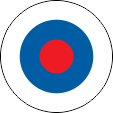 |
seit/since 1996, Flugzeugkokarde – aircraft roundel Quelle/Source, nach/by: Wikipedia (EN) |
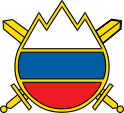 |
1991–1996, Flugzeugkokarde – aircraft roundel Quelle/Source, nach/by: Wikipedia (EN) |
Landkarten – Maps: |
|
Lage – Position: |
|
Landkarte des Landes – Map of the Country: |
|
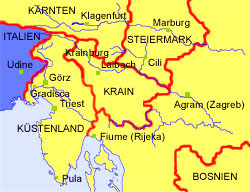 1880 |
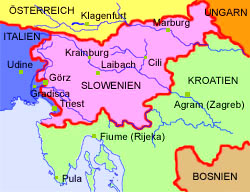 2005 |
Die
Staaten des früheren Jugoslawien – The countries of the former Yugoslavia: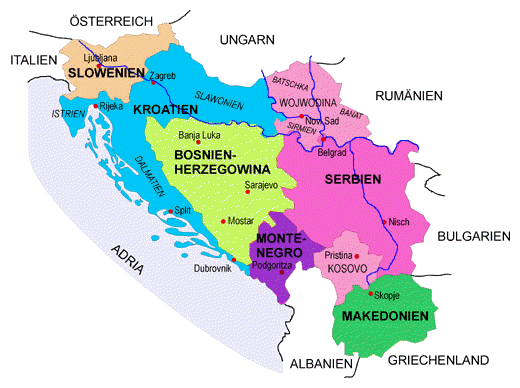 Landkarte/Map: Volker Preuß |
|
| Zahlen und Fakten – Numbers and Facts: | |
|
|
|
|
|
|
|
|
|
|
|
|
|
|
|
|
|
|
|
|
| Antike ·
von Illyrern besiedelt ca. 15 n.Chr. · die Eroberung Krains (Krain = Kernland des heutigen Slowenien) durch das Römische Reich ist abgeschlossen, zur Provinz Pannonia Superior 395 · bei der Teilung des Römischen Reiches kommt das heutige Krain an das Weströmische Reich 476–489 · Krain gehört zum Reich des Odoaker 489–553 · Krain gehört zum Reich der Ostgoten 6. Jhd. · Besiedlung durch Slawische Stämme 569–598 · Eroberung durch die Awaren ca. 800 · das heutige Krain wird durch das Frankenreich der Karolinger unterworfen, Bildung der "Mark Krain", Verwaltung durch den Markgrafen und Herzog von Friaul 934 · die Mark Krain kommt zu Bayern 976 · Krain kommt zum Herzogtum Kärnten 1394 · Krain (einschl. Istrien) wird selbstständiges Habsburgisches Herzogtum 1797–1809 · Französische Revolutionskriege: ein Teil Österreichs (Steiermark) wird 1797 von den Franzosen besetzt 1809 · Friede von Wien, Österreich verliert Salzburg, das Innviertel, Westgalizien und Teile von Ostgalizien und tritt Istrien, Triest, Görz, Krain, Kärnten, Kroatien, und Dalmatien an Frankreich ab, die 1810 zu den französischen "Illyrischen Provinzen" zusammengefasst werden 1813 · Österreich erklärt Frankreich (Napoléon) den Krieg 1814/1815 · Wiener Kongress, Neuordnung Europas nach der Ära Napoléon, das Kaiserreich Österreich (Haus Habsburg) erhält die 1809 verlorenen Gebiete zurück, sie werden zum Habsburgischen Königreich Illyrien zusammengefasst, Krain wird Teil des Habsburgischen Königreichs Illyrien, Dalmatien und Kroatien werden wieder an Ungarn (unter den Habsburgern, Teil des Kaiserreichs Österreich) angeschlossen 1848/1849 · Revolution in Wien, Bürgerkrieg zwischen Ungarn und Kroaten, Aufstände in Prag, Mailand und Venedig, daraufhin dankt Kaiser Ferdinand I. ab und Franz Joseph I. von Habsburg wird neuer Kaiser, die Aufstände werden niedergeschlagen und er erlässt eine neue Verfassung: die Titular-Erblande der Habsburger im Kaiserreich Österreich werden zu Kronländern mit eigenen Landtagen umgewandelt, der dalmatische Landtag lehnt den Anschluss an Kroatien ab, das Königreich Dalmatien wird ein eigenes Kronland der österreichischen Krone, Kroatien und Slawonien werden zum "Königreich Kroatien und Slawonien" vereinigt, das als Nebenland bei der ungarischen Krone verbleibt, Auflösung des Königreichs Illyrien: Aufteilung in die Kronländer Krain, Kärnten, Küstenland, Königreich Kroatien und Slawonien und Dalmatien 1914–1918 · Erster Weltkrieg, danach Zusammenbruch der Kaiserlich-Königlichen Monarchie, Zerfall von Österreich-Ungarn in Nationalstaaten 10.09.1919 · Friedensvertrag von Saint-Germain nach dem Ersten Weltkrieg, Österreich muss Krain und Teile Kärntens und Steiermarks an das "Königreich der Serben, Kroaten und Slowenen" (ab 1929 Jugoslawien genannt) abtreten, Krain wird dabei das Kernland der Banschaft Drau (das spätere Slowenien) 1939–1945 · Zweiter Weltkrieg, Jugoslawien ist zwischen 1941 und 1946 Schauplatz eines erbarmungslosen Partisanen- und Bürgerkriegs zwischen Kommunisten (unter J.P.Tito), Republikanern, Monarchisten und Nationalisten, die Kommunisten setzen sich durch 06.04.1941 · Einmarsch deutscher und italienischer Truppen 17.04.1941 · Kapitulation Jugoslawiens, Jugoslawien wird aufgelöst: der König flieht ins Exil, einige Gebiete müssen an Nachbarstaaten abgetreten werden (Makedonien, Kosovo, Banat und Slowenien), die Provinz Bosnien-Herzegowina wird Kroatien angeschlossen, Kroatien und Montenegro werden unabhängig, Serbien kommt unter deutsche Militärverwaltung, die Banschaft Drau wird zwischen dem Deutschen Reich (Nordteil) und Italien (Südteil) aufgeteilt 13.10.1943 · Kapitulation Italiens, daraufhin besetzt Deutschland unter anderem auch den Südteil der Banschaft Drau, die "Provinz Laibach / Ljubljanska Pokrajina" 19.02.1944 · Gründung von Bundes-Slowenien durch den Kommunistischen Widerstand 1945 · Eroberung und Besetzung der Region durch jugoslawische Partisanen, Vertreibung und teilweise auch Ermordung des größten Teils der im Lande verbliebenen deutschen Zivilbevölkerung 29.11.1945 · Ausrufung der "Föderativen Volksrepublik Jugoslawien" durch Tito 31.01.1946 · Gründung der Volksrepublik Slowenien (innerhalb des kommunistischen Jugoslawiens) 07.04.1963 · Ausrufung der Sozialistischen Republik Slowenien (innerhalb des kommunistischen Jugoslawiens) 08.03.1990 · Ausrufung der Republik Slowenien 25.06.1991 · Slowenien erklärt seine Unabhängigkeit von Jugoslawien Juli-August 1991 · Krieg gegen Jugoslawien Oktober 1991 · Rückzug der jugoslawischen Truppen 1992 · die Europäische Gemeinschaft (EG) erkennt Slowenien als unabhängig an, Slowenien tritt der UNO bei 2004 · Slowenien wird Mitglied der Europäischen Union 01.01.2007 · Einführung der Euro-Währung |
| Antiquity
· settlement by Illyrians ca. 15 A.D. · the conquest of Krain (Krain = the core of Slovenia) by the Roman Empire is finished, comes to the Province of Pannonia Superior 395 · at the partition of the Roman Empire Dalmatia comes to the West Roman Empire (Rome) 476–489 · Krain belongs to the Empire of the Odoaker 489–553 · belongs to Empire of the Eastern Goth 6th cent. · settlement by Slavic tribes 569–598 · conquest by the Pannonian Avars ca. 800 · the today's Krain becomes subjected by the Frankish Empire of the Carolingians, formation of the "Mark Krain", administration by the Margrave and Duke of Friaul 934 · the Mark Krain comes to Bavaria 976 · Krain comes to the Duchy of Carinthia 1394 · Krain (incl. Istria) becomes an own Duchy of the house of Habsburg 1797–1809 · French Revolutionar Wars, parts of Austria (Styria) become occupied by the French in 1797 1809 · Peace of Vienna, Austria loses Salzburg, the Inn Quarter, Western Galicia and parts of Eastern Galicia and cedes Istria, Trieste, Gorizia, Carniola, Carinthia, Croatia, and Dalmatia to France, which were merged in 1810 to the French "Illyrian Provinces" 1813 · Austria declares war on France (Napoléon) 1814/1815 · Congress of Vienna, realignment of Europe after the era Napoléon, the Empire of Austria (House of Habsburg) acquires back the in 1809 lost territories, they become merged to the Habsburg's Kingdom of Illyria, Carniola becomes a part of the Habsburg's Kingdom of Illyria, Dalmatia and Croatia become re-annexed to Hungary (under the Habsburgs, part of the Empire of Austria) 1848/1849 · revolution in Vienna, civil war between Hungarians and Croats, riotings in Prague, Mailand and Venice, as a result of that Emperor Ferdinand I. resigns and Franz Joseph I. of Habsburg becomes new Emperor, the riotings become suppressed and he enacts a new constitution: the titular hereditary territories of the Habsburgs in the Austrian Empire become converted to crown lands with their own Landtag (parliament), the Landtag of Dalmatia rejects the annexion to Croatia, the Kingdom of Dalmatia becomes an own crown land of the Austrian crown, Croatia and Slavonia become united to the "Kingdom of Croatia and Slavonia", which remains as a subsidiary country under the Hungarian crown, dissolution of the Kingdom of Illyria: division in the crown lands of Carniola, Carinthia, Littoral, Croatia and Slavonia and Dalmatia 1914–1918 · First World War, thereafter breakdown of the imperial-royal monarchy, disintegration of Austria-Hungary in national states 10th of September 1919 · Treaty of Peace of Saint-Germain after the First World War, Austria has to cede Krain and parts of Carinthia and Styria to the "Kingdom of the Serbs, Croats and Slovenes", since 1929 named Yugoslavia, Krain becomes the heartland of the Province of Drau (later Slovenia) 1939–1945 · Second World War, Yugoslavia is between 1941 and 1946 a location of a merciless partisan and civil war between communists (under J.P.Tito), republicans, monarchists and nationalists, the communists prevailed 6th of April 1941 · invasion of German and Italian troops 17th of April 1941 · capitulation of Yugoslavia, Yugoslavia becomes dissolved: the King escape into the exile, some territories have to cede to neighbouring states (Macedonia, Kosovo, Banat and Slovenia), the Province of Bosnia-Hercegovina gets incorporated into Croatia, Croatia and Montenegro get independent, Serbia comes under German military administration, the District od Drau becomes partitioned between the German Empire (northern part) and Italy (southern part) 13th of October 1943 · capitulation of Italy, as a result of that occupys Germany among others also the southern part of the District od Drau, the "Province of Laibach / Ljubljanska Pokrajina" 19th of February in 1944 · founding of Federal Slovenia by the communist resistance 1945 · conquest and occupation of the area of todays Slovenia by Yugoslav partisans, expulsion and partially even assassination of the largest part of the in the country remained German civilian population 29th of November 1945 · proclamation of the "Federative People's Republic of Yugoslavia" by Tito 31st of January in 1946 · founding of the People's Republic of Slovenia 7th of April in 1963 · proclamation of the Socialist Republic of Slovenia (within communist Yugoslavia) 8th of March in 1990 · proclamation of the Republic of Slovenia 25th of June 1991 · Slovenia declares its independence from Yugoslavia July–August 1991 · war aganist Yugoslavia October 1991 · withdrawal of the Yugoslav troops 1992 · the European Community (EC) recognizes Slovenia as independent, Slovenia joines the UNO 2004 · Slovenia becomes a member of the European Union 1st of January 2007 · introduction of the Euro Currency |
| Quelle/Source: Atlas zur Geschichte, World Statesmen, Wikipedia (D) |
| Der Name des Landes geht natürlich auf die Slowenen zurück, die wichtigste Volksgruppe des Landes. Das Wort "Slowene" geht auf das slawische Wort "slovit" zurück, was "sprechen" heißt. Die Slowenen sind also die "Sprechenden". Beachtenswert sind die Parallelen zur Slowakei, Slawonien und zu den "Slawen" überhaupt. | The name
of the country has its roots of course in the Slovenes, the most important
ethnic group of the country. The word "Slovene" is derived from the Slavic word "slovit", what means "speak". The Slovens are in this way the "speaking". Noteworthy are the parallels to Slovakia, Slavonia and to the "Slavians" anyway. |
| Quelle/Source: Handbuch der geographischen Namen | |